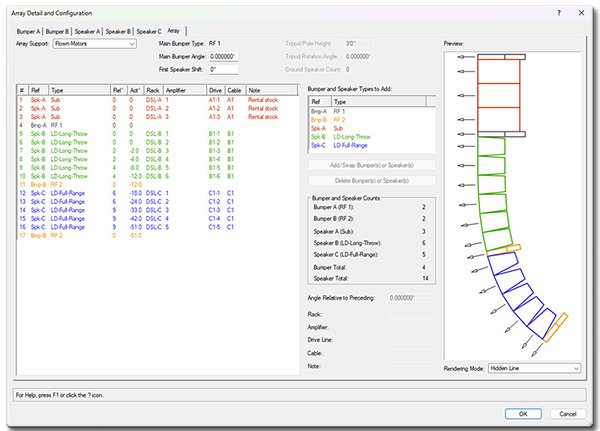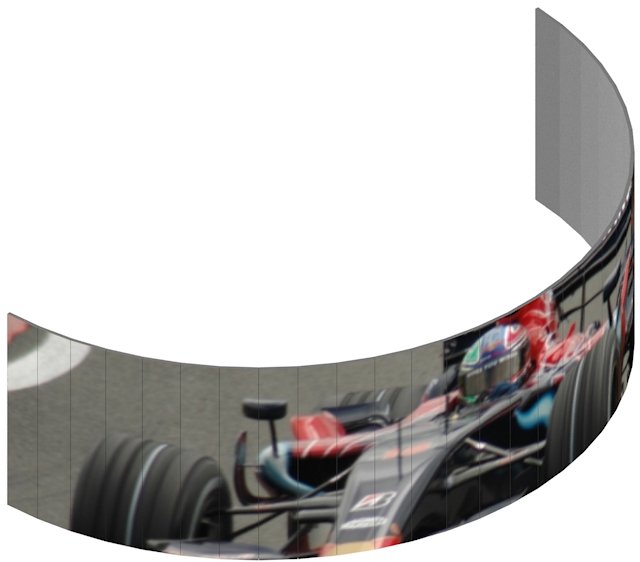-
Posts
1,151 -
Joined
Content Type
Profiles
Forums
Events
Articles
Marionette
Store
Everything posted by C. Andrew Dunning
-
Nothing has changed in this part of the code recently. My suspicion is 1 or more things are at-play, here: The panel count routine measures the actual distance between uprights (not center-to-center). So, the OIP might show a spacing of 3m that is actually 2.99m. The panel count routine doesn't allow for any sort of "precision allowance" that arguably should/could be factored in, considering the nature of dealing w. fabric. There might be an inconsistency between the panel count routine and that that draws the break markers. Some simple error-trapping needs to be relaxed a bit. Any way, like I said in my response to your initial post, addressing this is definitely on the "To Be Addressed"/"Gotta Fix" list. You are not being ignored or brushed off; delving into this will simply take some time.
-
This might help: CreateText (TxtStr1); (Creates block of text) TxtHndTmp := LNewObj; (Assigns the block of text to a handle) SetTextWrap (TxtHndTmp,true); (Tells the text block to wrap) SetTextWidth (TxtHndTmp, PBlkWdth); (Tells the block of text how wide it is to be)
-
There isn't an automatic way to do this. You'll have to build your truss structure and use a television casing Symbol that includes a mounting bracket.
-
@benghiat's Projection Viz allows for this. https://benghiatlighting.com/software/product/projectionviz-1/#description
-
Using the "horse-shoe" shaped instance as a reference, there are 2 things going on in your file: The longest distance between the verticals is 2.95m (measured from inside of vertical to inside of vertical) or 2.99m (measured from vertical centers). So, as your stock drape width is more than that, the count of 11 is correct. While there is not overlap, the overlap graphics are still being created on the long sides. That part is not correct. I confirmed the same issue in both the Spotlight and the Landru version of the tool. Now on the "Gotta Fix" list...
-
Stage steps will not allow a height taller than 2ft.
C. Andrew Dunning replied to Scrappy_Bogart's topic in Entertainment
A maximum single-step rise of 2' and a minimum single-step rise of 2" are hard-coded into the tool. -
Add my own image to a projection screen
C. Andrew Dunning replied to Tyrrellian's topic in Entertainment
In your VW file, create an Image-Based Texture. Select the Video Screen object. Click the "Edit Screen Image..." button in the OIP. In the picker in the upper left-hand corner of the dialig that opens, select the Texture you just created. Click OK. -
Same, here.
-
Attached is a gear count Worksheet I use. While it is looking for the Landru Design versions of the tools, it might be helpful in this conversation. Note the Script that the SoftGoods portion uses. LandruCountDemo.vwx
-
Speaker Array - Rigging Frames & Pull-Back Bar
C. Andrew Dunning replied to Mark Aceto's topic in Entertainment
Good question! The best answer I can give is "maybe." It really depends on user demand and what Vectorworks chooses to license.- 23 replies
-
- speaker
- speaker array
-
(and 1 more)
Tagged with:
-
-
Speaker Array - Rigging Frames & Pull-Back Bar
C. Andrew Dunning replied to Mark Aceto's topic in Entertainment
For those of you still following this thread, we just released updates for all of our tools. As part of that, AudioArray 2 now supports multiple bumper types: If you're interested, see http://www.landrudesign.com/VWPlugIns.htm for more info.- 23 replies
-
- 2
-

-

-
- speaker
- speaker array
-
(and 1 more)
Tagged with:
-
Convert pipe and drape to stanchions
C. Andrew Dunning replied to Josh_M_Gill's topic in Entertainment
No. When developing Stanchion Layout I toyed w. such an idea. The tools "think" differently enough that I scrapped that thinking early-on. Not a bad question, though... -
Controlling Dimension Text Inside a PIO
C. Andrew Dunning replied to Sam Jones's topic in Vectorscript
A thought: Create a Procedure called "JonesTextPlace. In it, make all of the text settings you'd like - size, alignment, justification, etc. Bookend everything w. PushAttrs & PopAttrs. Doing that will reset values automatically. -
Controlling Dimension Text Inside a PIO
C. Andrew Dunning replied to Sam Jones's topic in Vectorscript
Why the concern. All of my tools use that call w/o issue. -
Controlling Dimension Text Inside a PIO
C. Andrew Dunning replied to Sam Jones's topic in Vectorscript
Try TextSize. -
SetDashStyleN & SetDashStyle create a new Line Style with a given name. Name2Index returns the index # for the given name. That help??
-
Would anyone be up for an object-building "challenge"?
C. Andrew Dunning replied to SamIWas's topic in Vectorscript
Another way to answer your question: Place a Spotlight Stage Lift object. Now, make changes like entering different heights - including known undoables, like 60'. The object will reconfigure itself. Now, imagine creating the object from-scratch (extrudes, sweeps, moves, textures, etc.) and making changes manually - to either 2D or 3D...or, both. The Stage Lift object is 100% VectorScript generated (including texture generation) and changes are sub-second as needs change. That help??? -
Would anyone be up for an object-building "challenge"?
C. Andrew Dunning replied to SamIWas's topic in Vectorscript
Happy to give you my 2¢ whenever you'd like. FWIW, PayPal makes the financial end of things pretty simple. -
Would anyone be up for an object-building "challenge"?
C. Andrew Dunning replied to SamIWas's topic in Vectorscript
Interested and following but no bandwidth to participate. My code-time is all soaked by the never-ending wish-list for my current tool line-up (which, BTW, other than the bits that embed Symbols, all are written in VectorScript). The latest feature addition has turned into consuming several days spanning multiple weeks. FWIW, @SamIWas, if the quality of your other tools is along the lines of what you posted, it might be worth considering selling licenses. Ya might get some ROI... -
The 3D portion of your Symbol is an embedded 3D Symbol - which will not work with tilted speakers. See the attached corrected file. A10 VW speakertest.vwx
-
Would you post a file containing a copy of the Symbol that doesn't render correctly? There might be an issue with how the 3D portion was created.
-
Landru Tools (including Audio tools) Updated!
C. Andrew Dunning replied to C. Andrew Dunning's topic in Entertainment
Like, a "vertical" diamond? At this time, no. That is doable, though, using Design Layer Viewports. Sort of. For each, a VS4-LED instance would represent a single tile. You would build the array and then (either manually or using a Command I share with our users) adjust image scaling and shifting so that each panel shows a portion of the overall image. Like this: -
Landru Tools (including Audio tools) Updated!
C. Andrew Dunning replied to C. Andrew Dunning's topic in Entertainment
Assuming you are meaning our version of the LED tool, there are several differences. Here are a few of the things that are unique to our version: 3D text blocks. Several additional text fields. Ability to collapse parts of the OIP. Inclusion of the Coverage Zone feature found in the other video tools. Display of secondary dimension units allowing users to display array dimensions in, for example, meters if drawing units are in feet and inches. Ability to build half-tiles. Ability to miter vertical edges of end tiles. Weight and power estimates automatically re-calculate as tile counts change. While the tools don't have a specific way to track that information, you could use the "Raster" or "Note" field for that. I hope that this answers some of your questions. Feel free to ask if you have more.




